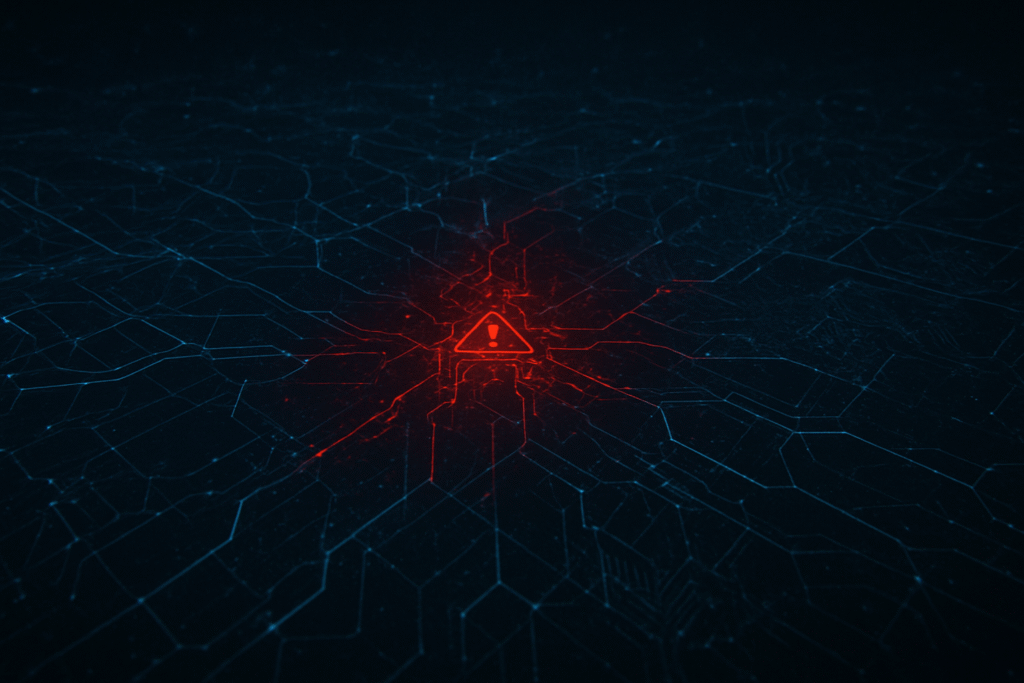
On Wednesday, October 29, 2025, Microsoft's Azure cloud platform experienced a significant global outage, sending ripples of disruption across countless businesses, essential services, and individual users worldwide. The incident, which began around 9 a.m. Pacific Time (16:00 UTC), swiftly brought down a vast array of Microsoft's own offerings, including Microsoft 365, Xbox Live, and the Azure Portal itself, while simultaneously incapacitating numerous third-party applications and websites that rely on Azure's foundational infrastructure. This widespread disruption not only highlighted the precarious dependency of the modern digital world on a handful of hyperscale cloud providers but also cast a harsh spotlight on cloud service reliability just hours before Microsoft's scheduled quarterly earnings report.
The immediate significance of the outage was profound, halting critical business operations, frustrating millions of users, and underscoring the cascading effects that even a partial failure in a core cloud service can trigger. From corporate employees unable to access essential productivity tools to consumers unable to place mobile orders or access gaming services, the incident served as a stark reminder of how deeply intertwined our daily lives and global commerce are with the health of the cloud.
The Technical Fallout: DNS, Azure Front Door, and the Fragility of Connectivity
The root cause of the October 29th Azure outage was primarily attributed to DNS (Domain Name System) issues directly linked to Azure Front Door (AFD), Microsoft's global content delivery network and traffic routing infrastructure. Microsoft suspected an "inadvertent configuration change" to Azure Front Door as the trigger event. Azure Front Door is a critical component that routes traffic across Microsoft's vast cloud environment, and when its DNS functions falter, it prevents the proper translation of internet addresses into machine-readable IP addresses, effectively blocking users from reaching applications and cloud services. This configuration change likely propagated rapidly across the Front Door infrastructure, leading to widespread DNS resolution failures.
The technical impact was extensive and immediate. Users globally reported issues accessing the Azure Portal, with Microsoft recommending programmatic workarounds (PowerShell, CLI) for critical tasks. Core Microsoft 365 services, including Outlook connectivity, Teams conversations, and access to the Microsoft 365 Admin Center, were severely affected. Gaming services like Xbox Live multiplayer, account services, and Minecraft login and gameplay also suffered widespread disruptions. Beyond Microsoft's ecosystem, critical third-party services dependent on Azure, such as Starbucks.com, Chris Hemsworth's fitness app Centr, and even components of the Dutch railway system, experienced significant failures. Microsoft's immediate mitigation steps included failing the portal away from Azure Front Door, deploying a "last known good" configuration, and blocking further changes to AFD services during the recovery.
This type of outage, centered on DNS and a core networking service, shares commonalities with previous major cloud disruptions, such as the Dyn outage in 2016 or various past AWS incidents. DNS failures are a recurring culprit in widespread internet outages because they are fundamental to how users locate services online. The cascading effect—where a problem in one foundational service (Azure Front Door/DNS) brings down numerous dependent applications—is also a hallmark of large-scale cloud outages. However, the timing of this event, occurring just a week after a significant Amazon Web Services (NASDAQ: AMZN) disruption, intensified concerns about the internet's heavy reliance on a limited number of providers, prompting some initial speculation about a broader, systemic internet issue, though reports quickly focused on Azure's internal problems.
Initial reactions from the tech community and industry experts were characterized by frustration and a swift migration to social media for updates. Outage tracking sites like Downdetector recorded massive spikes for Azure, Microsoft 365, and Xbox. Experts quickly underscored the inherent fragility of even the largest cloud infrastructures, emphasizing that partial failures in foundational services can have global repercussions for businesses, gamers, and everyday users. The timing, just hours before Microsoft's (NASDAQ: MSFT) quarterly earnings call, added an extra layer of scrutiny and pressure on the company.
Corporate Ripples: From Starbucks to Silicon Valley
The October 29th Azure outage sent shockwaves through a diverse array of businesses, highlighting the pervasive integration of cloud services into modern commerce. Companies like Alaska Airlines faced disruptions to their website and app, impacting customer check-ins and flight information. Retail giants Starbucks, Kroger, and Costco saw their cloud-dependent operations, including mobile ordering, loyalty programs, inventory management, and point-of-sale systems, severely compromised, leading to lost sales and operational paralysis. Chris Hemsworth's fitness app, Centr, also reported significant service interruptions, demonstrating the broad reach of Azure's impact across consumer services. Beyond these specific examples, countless other businesses globally, from healthcare organizations experiencing authentication issues to government services in Canada, found their operations hobbled.
For Microsoft (NASDAQ: MSFT) itself, the outage was a significant blow. Beyond the disruption to its core cloud platform, its own suite of services—Microsoft 365, Teams, Outlook, Xbox Live, Minecraft, Copilot, and LinkedIn—all suffered. This internal impact underscored the extent to which Microsoft itself relies on its Azure infrastructure, making the incident a critical test of its internal resilience. The timing, preceding its quarterly earnings report, added a layer of public relations challenge and intensified investor scrutiny.
The competitive implications for major cloud providers—Microsoft (NASDAQ: MSFT), Amazon (NASDAQ: AMZN), and Google (NASDAQ: GOOGL)—are substantial. The "dual failure" of a significant AWS (NASDAQ: AMZN) outage just a week prior, followed by Azure's widespread disruption, has intensified discussions around "concentration risk" within the cloud market. This could compel businesses to accelerate their adoption of multi-cloud or hybrid-cloud strategies, diversifying their reliance across multiple providers to mitigate single points of failure. While such diversification adds complexity and cost, the operational and financial fallout from these outages makes a strong case for it.
For Microsoft, the incident directly challenges its market positioning as the world's second-largest cloud platform. While its response and resolution efforts will be crucial for maintaining customer trust, the event undoubtedly provides an opening for competitors. Amazon (NASDAQ: AMZN) Web Services, despite its own recent issues, holds the largest market share, and consistent issues across the leading providers could lead to a broader re-evaluation of cloud strategies rather than a simple migration from one to another. Google (NASDAQ: GOOGL) Cloud Platform, as the third major player, stands to potentially benefit from businesses seeking to diversify their cloud infrastructure, assuming it can project an image of greater stability and resilience. The outages collectively highlight a systemic risk, pushing for a re-evaluation of the balance between innovation speed and foundational reliability in the cloud industry.
Wider Implications: Cloud Reliability, Cybersecurity, and the AI Nexus
The October 29, 2025, Microsoft Azure outage carries profound wider significance, reshaping perceptions of cloud service reliability, sharpening focus on cybersecurity, and revealing critical dependencies within the burgeoning AI landscape. The incident, following closely on the heels of an AWS outage, underscores the inherent fragility and interconnectedness of modern digital infrastructure, even among the most advanced providers. It highlights a systemic risk where the concentration of digital services within a few major cloud providers means a single point of failure can trigger a cascading effect across numerous services and industries globally. For businesses, the operational downtime translates into substantial financial losses, further emphasizing the need for robust resilience strategies beyond mere uptime.
While the Azure outage was attributed to operational issues rather than a direct cyberattack, such widespread disruptions inevitably carry significant cybersecurity implications. Outages, regardless of cause, can expose system vulnerabilities that cybercriminals might exploit, creating opportunities for data breaches or other malicious activities. The deep integration of third-party platforms with first-party systems means a failure in a major cloud provider directly impacts an organization's security posture, amplifying third-party risk across global supply chains. This necessitates a unified approach to managing both internal and vendor-related cybersecurity risks, moving beyond traditional perimeter defenses.
Crucially, the outage has significant implications for the rapidly evolving AI landscape. The 2020s are defined by intensive AI integration, with generative AI models and AI-powered applications becoming foundational. These AI workloads are heavily reliant on cloud resources for real-time processing, specialized hardware (like GPUs), and massive data storage. An outage in a core cloud platform like Azure can therefore have a magnified "AI multiplier" effect, halting AI-driven analytics, disabling customer service chatbots, disrupting supply chain optimizations, and interrupting critical AI model training and deployment efforts. Unlike traditional applications that might degrade gracefully, AI systems often cease to function entirely when their underlying cloud infrastructure fails. This highlights a "concentration risk" within the AI infrastructure itself, where the failure of a foundational cloud or AI platform can cause widespread disruption of AI-native applications.
Potential concerns arising from this incident include an erosion of trust in cloud reliability, increased supply chain vulnerability due to reliance on a few dominant providers, and likely increased regulatory scrutiny over service level agreements and resilience measures. The pervasive outages could also hinder the broader adoption of AI-native applications, particularly in mission-critical environments where uninterrupted service is paramount. While AI is a transformative tech milestone, this outage serves as a critical test of the resilience of the infrastructure supporting AI, shifting focus from celebrating AI's capabilities to ensuring its foundational robustness.
The Road Ahead: Building Resilient Cloud Ecosystems
In the wake of the October 29th Azure outage, the tech industry is poised for significant shifts in how cloud reliability and cybersecurity are approached. In the near term, a pronounced acceleration in the adoption of multi-cloud and hybrid cloud strategies is expected. Organizations will move beyond simply using multiple clouds for redundancy; they will actively design systems for seamless workload shifting and data replication across different providers to avoid vendor lock-in and mitigate single points of failure. This "design for failure" mentality will become paramount, fostering architectures that anticipate and gracefully handle disruptions.
Long-term developments will likely include more sophisticated AI-driven cloud orchestration and management. AI and machine learning will play a more significant role in predicting and preventing issues before they escalate, optimizing resource allocation dynamically, and automating failover mechanisms. The integration of enhanced edge computing will also grow, bringing data processing closer to the source to reduce latency, bandwidth dependence, and increase resilience, especially for real-time AI applications in sectors like industrial IoT and autonomous vehicles.
Challenges remain formidable, including the inherent complexity of managing security and operations across multi-cloud environments, the persistent threat of human error and misconfigurations, and the ongoing shortage of skilled cloud and cybersecurity professionals. Moreover, advanced persistent threats and evolving malware will continue to challenge even the most robust security measures. Experts predict a recalibration of cloud strategies, moving beyond mere uptime to a deeper focus on inherent resilience. This includes a demand for greater transparency and accountability from cloud providers regarding outage reports and redundancy measures, potentially leading to global frameworks for cloud reliability.
Comprehensive Wrap-up: A Call for Cloud Resilience
The Microsoft Azure outage on October 29, 2025, serves as a pivotal moment, underscoring the critical need for enhanced resilience in our increasingly cloud-dependent world. The key takeaway is clear: no cloud infrastructure, however advanced, is entirely immune to disruption. The incident, marked by DNS issues stemming from an "inadvertent configuration change" to Azure Front Door, exposed the profound interconnectedness of digital services and the cascading impact a single point of failure can unleash globally. Coming just after a significant AWS outage, it highlights a systemic "concentration risk" that demands a strategic re-evaluation of cloud adoption and management.
In the annals of cloud and AI history, this event will be remembered not as a breakthrough, but as a crucial stress test for the foundational infrastructure supporting the digital age. It emphasizes that as AI becomes more pervasive and critical to business operations, the stability and security of its underlying cloud platforms become paramount. The long-term impact on the tech industry and society will likely manifest in a heightened emphasis on multi-cloud and hybrid cloud strategies, a renewed focus on designing for failure, and accelerated investment in AI-driven tools for cloud orchestration, security, and disaster recovery.
Moving forward, the industry must prioritize transparency, accountability, and a proactive approach to building resilient digital ecosystems. What to watch for in the coming weeks and months includes Microsoft's comprehensive post-mortem, which will be critical for understanding the full scope of the incident and its proposed remediations. We should also anticipate intensified discussions and initiatives around cloud governance, regulatory oversight, and the development of industry-wide best practices for mitigating systemic risks. The Azure outage is a powerful reminder that while the cloud offers unparalleled opportunities, its reliability is a shared responsibility, demanding continuous vigilance and innovation to ensure the uninterrupted flow of our digital future.
This content is intended for informational purposes only and represents analysis of current AI developments.
TokenRing AI delivers enterprise-grade solutions for multi-agent AI workflow orchestration, AI-powered development tools, and seamless remote collaboration platforms.
For more information, visit https://www.tokenring.ai/.




